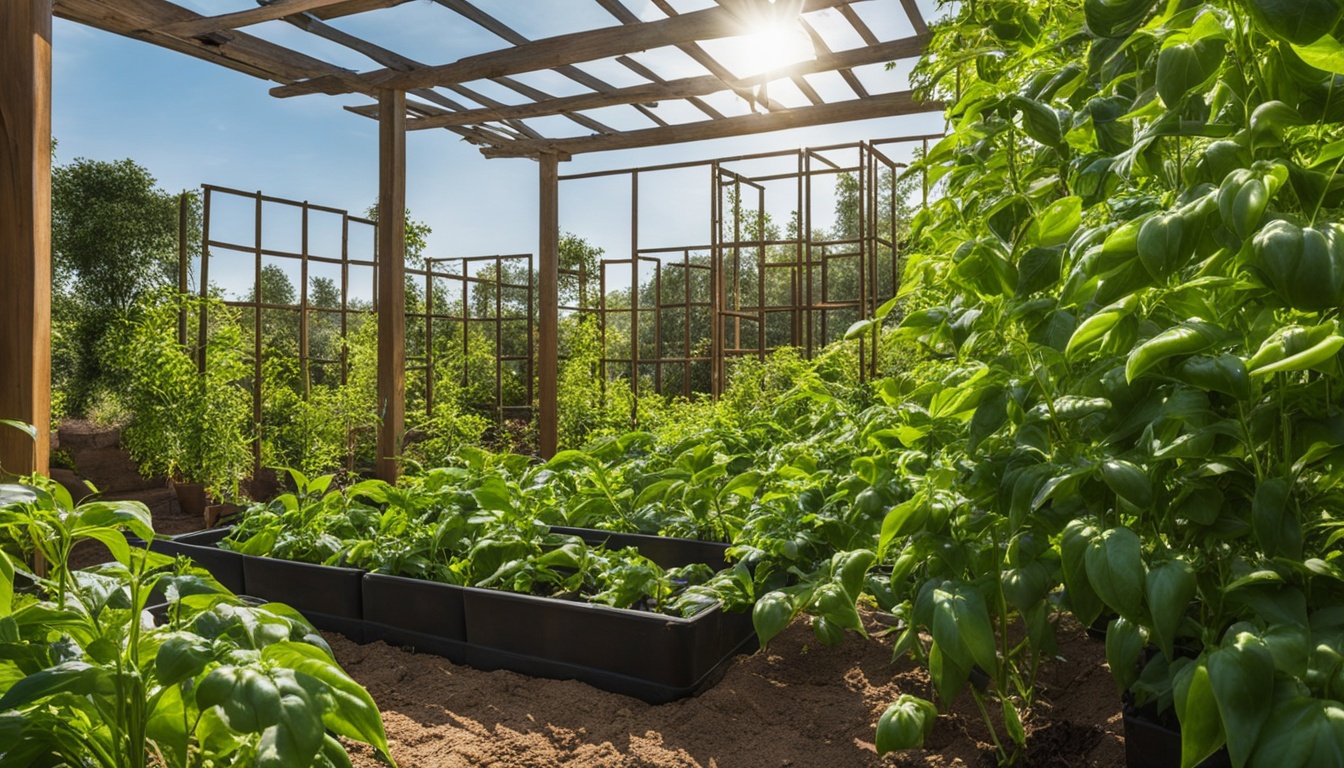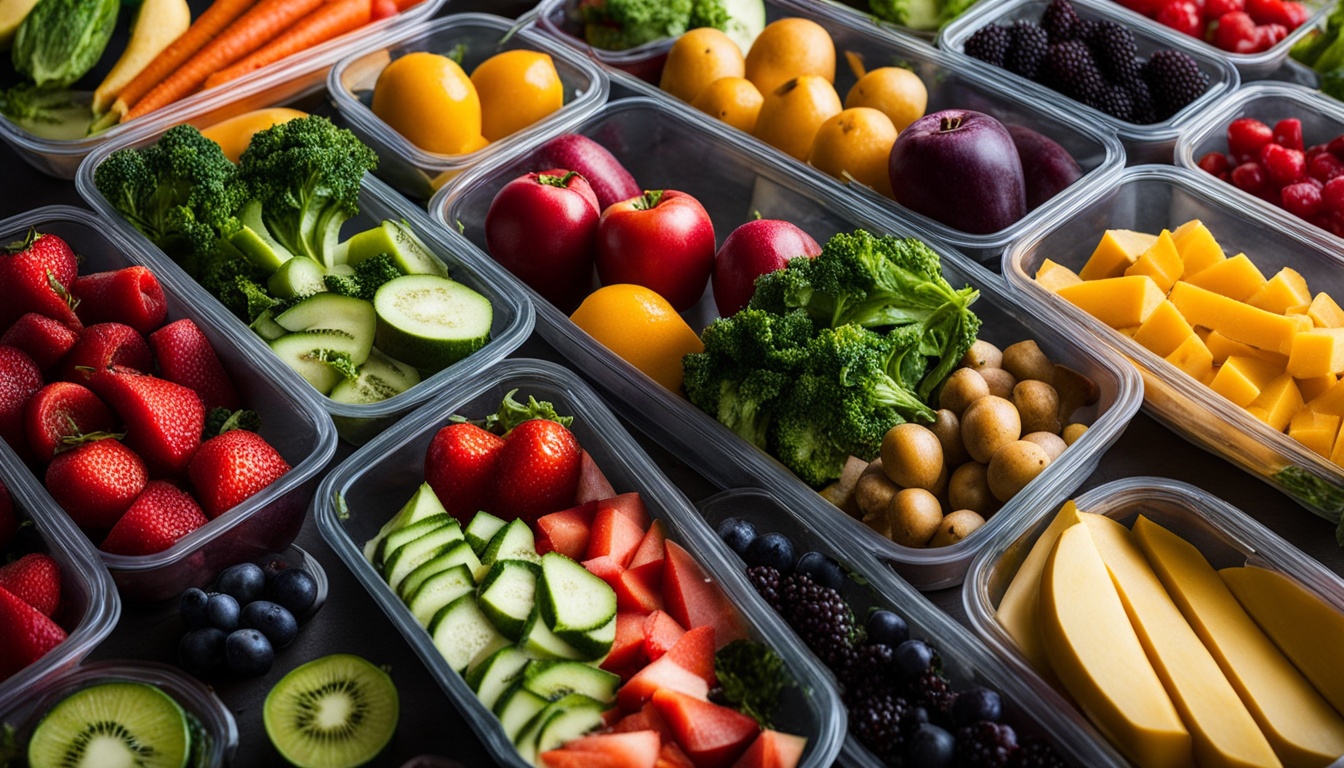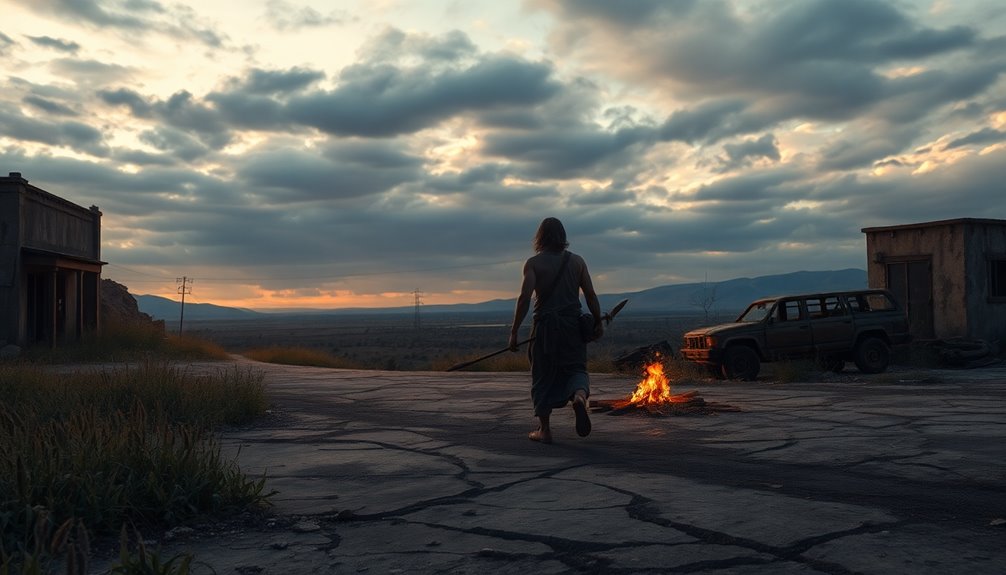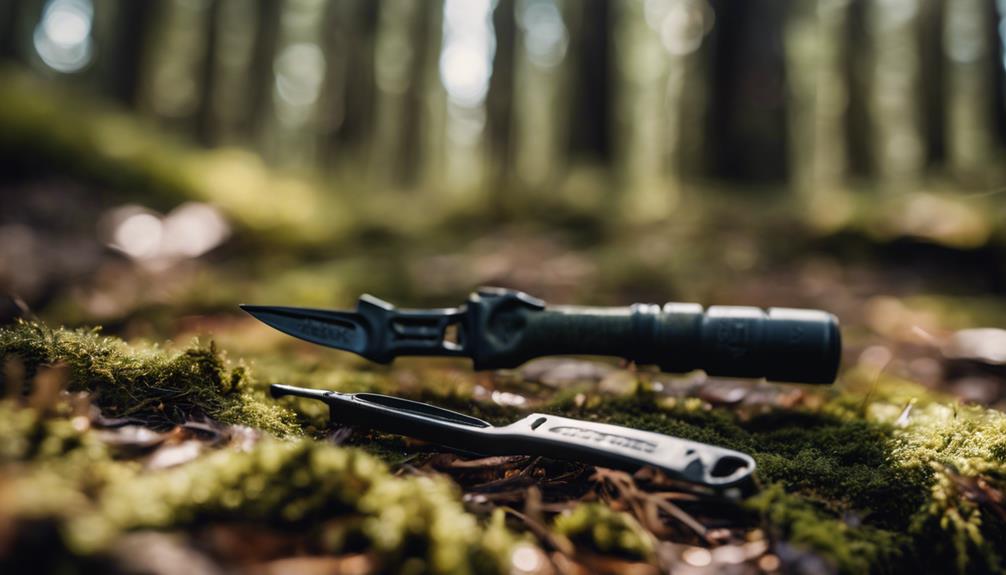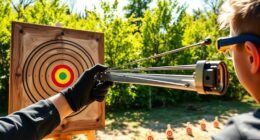Are you drawn to the thrill of spice? Does the thought of fiery peppers excite you? If yes, growing peppers might be your calling. Let’s dive into the world of pepper cultivation together. We’ll discover how to grow bold, spicy peppers in your backyard.
Key Takeaways
- Discover essential tips for cultivating a bountiful harvest of spicy peppers
- Learn about overwintering techniques for faster pepper maturation.
- Uncover the importance of high-quality, untreated seeds for natural growth.
- Explore planting guidance to ensure successful germination and transplanting.
- Discover preservation methods to savor your spicy harvest year-round.
Choosing the Right Seeds and Germination Methods
To start your pepper garden, choosing the right seeds is vital. Good seeds lead to successful pepper growth. Choose natural, untreated seeds for the best start1. Soaking seeds before planting speeds up germination, giving your plants a quick start1.
Tips for Transplanting and Growing Pepper Seedlings
After your seeds germinate, it’s transplant time. Pepper plants love warmth, thriving in 75 to 80°F2. Gradually introducing seedlings to the outdoors strengthens them2. Space them about two feet apart to avoid overcrowding2. Remember, peppers dislike frost, so wait until it’s warm late in spring2.
Maximizing Fruit Production and Harvesting Tips
To get the most from your plants, deep mulch them. 6-8 inches of mulch keeps moisture in, fights weeds, and supports growth2. As peppers ripen, they change colors, adding beauty to your garden2. Harvesting at the right size boosts further production, offering more spicy treats2.
Preserving and Using Your Pepper Harvest
When you’ve got lots of peppers, preservation is key. Try drying, pickling, freezing, or roasting to keep them longer1. Drying peppers in sunlight preserves their spicy flavor1. Pickling adds unique tastes to dishes1. Freezing keeps peppers fresh and spicy1. Roasting and crushing dried peppers adds a kick to meals1.
Extending the Pepper Growing Season
In colder places, keeping pepper plants growing longer can be tricky. But, with the right approach, it’s possible. Overwintering speeds up maturation by focusing the plant’s energy1. Hanging plants upside down in a dry area before freezing helps ripen them1. These methods let you enjoy fresh peppers even longer.
The Hottest Pepper Varieties
For those who love extreme spice, trying the hottest peppers is a must. The Carolina Reaper and Moruga Trinidad Scorpion are among the fieriest1. If you enjoy challenging your taste buds or impressing friends, these peppers are perfect.
Container Gardening for Limited Garden Space
Limited space? No problem. Container gardening is a great alternative. Choose compact varieties and ensure good drainage in your pots. This way, you can move your plants to catch sunlight, needing at least six hours daily1. Container gardening makes growing peppers possible anywhere.
Bartering and Trading Peppers
If you’ve got more peppers than you can eat, think about trading. Pepper lovers often exchange varieties, sharing their passion3. This exchange broadens your pepper variety and builds friendships based on a love for spicy foods.
Conclusion
Growing peppers adds excitement and flavor to gardening. With these tips, you’re set to start. From seed selection to preserving your bounty, endless spicy possibilities await. Embark on this fiery journey and bring a burst of heat to your dishes with homegrown peppers.
Choosing the Right Seeds and Germination Methods
To start growing spicy peppers, choosing the right seeds and germination methods is key. With the right choices, your plants will be strong and produce lots of peppers. Let’s look at what you should think about when picking seeds and starting the germination.
Pepper seeds come in different types like heirloom, hybrid, and GMO seeds4. Heirloom seeds are old and valued for their history4. Hybrid seeds have special traits but aren’t GMOs4. Think about what you want from your garden when choosing.
Seed packets tell you important stuff like how much sun and space pepper plants need4. This helps you plant them right for the best growth.
“The germination rate is a crucial factor to consider when selecting and handling pepper seeds.”
The germination rate tells you how many seeds will sprout4. Pick seeds with a high germination rate to avoid wasting seeds and effort.
Some companies sell seed collections with different peppers and guides4. These kits are great for beginners who want to try growing different kinds.
Wild peppers, like wild garlic, differ a lot from the ones we grow4. Decide if you want traditional peppers or something more unique.
Pre-sprouted plants can be easier to start in your garden4. They cost more but are good for plants like tomatoes and peppers4.
We’ve talked about selecting seeds. Now, let’s discuss key germination methods.
Soak your pepper seeds overnight in warm water or potassium nitrate solution to start germination5. Then, use a mix of garden soil, composted cow manure, and sand5. Plant the seeds 1/4 inch deep and keep the soil moist5. This helps seedlings grow well.
Pepper seedlings need lots of sunlight, at least six hours a day4. A warm temperature between 70-90°F also helps peppers germinate better5.
Tips for Transplanting and Growing Pepper Seedlings
Once pepper seedlings sprout, it’s transplant time. Give them the right care to grow into healthy, fruitful pepper plants.
Transplanting Seedlings
Introduce seedlings to sunlight slowly and support their growth. This helps them adapt and strengthens stems. Use stakes or cages for support.
Reference:6
Choosing the Right Soil
The right potting soil is key for your seedlings. Choose a light, fluffy mix that drains well. Go for a peat moss or coco coir-based potting soil with a pH of 5.9-6.5, enriched with organic fertilizer.
Reference:7
Fertilizing the Plants
Fertilization is crucial for pepper plants’ health. Use organic fertilizers like fish emulsion. Begin liquid fertilization when seedlings have two sets of true leaves to enhance growth and fruit yield.
Preventing Pests and Diseases
Keep an eye on your plants for pests and diseases. Address problems early. Ensure good airflow to prevent issues, using a fan if needed. This strengthens stems too.
Reference:8
Proper Spacing and Plant Support
Space hot pepper seedlings well, about 2-3 feet apart. This lets branches spread. Staking or using cages is key for support as they grow tall and heavy.
Reference:7
Ensuring Adequate Nutrients and Sunlight
Peppers need nutrients and sun to thrive. Add lime and organic fertilizer to the soil. This prevents problems and promotes growth. Keep plants in full sun, at least 14-16 hours of light a day. Grow lights should be 7-12 inches from the plant to avoid leaf burn.
Reference:7
By following these tips, you’re on your way to a great pepper harvest. Happy growing!

Maximizing Fruit Production and Harvesting Tips
To get lots of peppers, focus on a few key steps. By using the right methods, you can grow more peppers. These will be tasty and spicy.
Creating the Ideal Growing Conditions
Peppers need the right soil to grow well. Add bone meal or a mix of lime and wood ash for key nutrients. This will make your plants strong and boost pepper amounts9.
It’s also important to protect your plants from wind. Strong winds can break the plants and lower your pepper count. Use windbreakers or plant in places that block the wind.
Check your plants often for bugs. Deal with pests like aphids and whiteflies quickly to stop them from damaging your plants. Choosing natural pest controls helps keep your peppers safe to eat.
Harvest at the Right Time
Pick your peppers when they’re fully ripe for the best taste. Look for bright colors, firmness, and a strong smell. Use a gentle twist or scissors so you don’t hurt the plant.
Harvesting ripe peppers means they’ll taste better and be spicier. Keep in mind that the hotter the pepper, the spicier it will be. Think about how much spice you like before you pick them.
Additional Tips for Maximizing Fruit Production
Want more peppers? Here are extra tips:
- Water your pepper plants well, about 1 inch per week. This keeps them healthy and helps them make more peppers9.
- Use black plastic or mulch to keep the soil moist and weed-free. This makes the soil conditions just right for more peppers9.
- Give your plants support as they grow. Stakes or cages keep them upright, loaded with peppers9.
- Be careful not to overuse nitrogen fertilizers. Too much can harm fruit growth. A balanced fertilizer is better910.
- Warmth is key for setting fruit. If it’s under 72°F, find ways to warm your plants. Consider row covers or greenhouses to lengthen the growing season911.
By following these tips and taking good care of your pepper plants, you can grow a large harvest of tasty and spicy peppers.

| Statistic | Data |
|---|---|
| Optimal Planting Time | USDA hardiness zones help you know when to plant. For example, Albuquerque, New Mexico: 7b; Columbus, Ohio: 6a; Houston, Texas: 9a; Nashville, Tennessee: 7a; Orlando, Florida: 9b; Portland, Maine: 5b; Tucson, Arizona: 9b11. |
| Average Last Frost | In zone 5 (WI), the last frost usually happens in mid-May9. |
| Recommended Plant Spacing | It’s best to space pepper seedlings 18 inches apart. They should be in rows on 3 1/2 – 4 feet wide beds9. |
| Number of Pepper Plants | You can grow up to 35 pepper plants each year. This is great for people who love peppers9. |
| Optimal Temperatures | Pepper plants do best in temperatures between 75-86°F. This weather is perfect for growing lots of fruit9. |
Preserving and Using Your Pepper Harvest
If you’ve got too many peppers, don’t worry, there are lots of ways to keep them for later. You can string hot peppers up and dry them in a sunny spot by a window. Or just lay them on a plate in a spot that’s not too moist12. Blanching and pickling peppers give them a zesty twist you’ll love13. Or, freeze them after a quick wash to keep them tasting fresh anytime you want13. You can even roast and crush dried hot peppers to make a special spice blend14. Try mixing up different types of peppers in your cooking for fun.

Pickling peppers is a great choice for keeping their zingy taste. First, blanch them, then soak in a mix of vinegar and spices. This keeps their bright color and crisp texture. Pickled peppers are great in sandwiches, salads, or as a fun topping12.
Freezing peppers is handy and keeps them good for months. You can use quart-size bags or vacuum-seal them for even longer storage12. Lay the bags flat in the freezer to save space and make grabbing some easy. Thawing them out is quick, taking about 10 minutes13.
Drying peppers is another cool way to save them for later. Dehydrated peppers are perfect in soups, salads, or as a crunchy snack12. The drying process makes their flavor stronger and keeps them good for a long time. You can grind dried peppers to spice up your meals13.
Tips for Freezing Peppers
Try mixing peppers and onions before freezing, using twice as many peppers. This mix tastes great when cooked12. Make sure to clean the peppers and take out the seeds before freezing12. Spread them on a tray with freezer paper. Freeze until solid, then put them in a container. This way, you can use just the amount you need without thawing everything13.
Extending the Pepper Growing Season
Want to get more peppers from your plants for a longer time? You can, with a few smart tricks. Practices like overwintering, pruning, and careful moving of plants can help. These methods let your pepper plants live longer, even in cool places.
Pruning your pepper plants is a good way to keep them producing. Cut the tops off about six weeks before the cold hits. This makes the plant focus on the peppers already growing. It speeds up their growth and ripening. You’ll get more peppers before it gets too cold15.
If you live where it gets really cold, try overwintering your peppers. Take the whole plant out and hang it upside down in a dry place. The green peppers will keep getting ripe. This is great for short-season climates and boosts your pepper count15.

To keep your peppers growing longer, they need the right conditions. Peppers germinate best in soil that’s between 65F and 90F. They need 16 hours of light and 8 hours of darkness each day. About 4-6 weeks after sprouting, move them to a bigger pot. Prune them when they have about 6 true leaves or are 4 inches tall15.
Before moving peppers outside, make sure it stays above 60F at night. Get them used to the outside for a week first. Choose a sunny spot for planting. Use compost to feed them. After planting outside, peppers might grow slow at first but will soon speed up15.
Growing peppers in pots as perennials can help people with little room or living in cold places. This lets you start picking fruit earlier and get more peppers. Pick the right varieties and take good care of them. Then, enjoy peppers all year long1516.
Summary:
To get more peppers for longer, try pruning and overwintering. Pruning helps peppers ripen faster. Overwintering lets green peppers ripen off the plant. Be sure your peppers have what they need: right soil temperature, enough light, and gradual outdoor exposure. For those with less space, growing peppers in pots can bring an early and bigger harvest. Follow these tips to enjoy your homegrown peppers even when it’s cold out.
The Hottest Pepper Varieties
If you love spicy food, you might want to grow the hottest peppers out there. These peppers are famous for their extreme heat. They are a big hit with chili fans. So, let’s look at some hot pepper types that can make your dishes super spicy.
Carolina Reaper

The Carolina Reaper is among the world’s hottest peppers, holding the Guinness World Record. It looks wrinkly and tastes fruity but is super hot, with over 2,200,000 Scoville Heat Units (SHU). Grown in the USA, this pepper is really strong. Add just a little to make any meal extra hot17.
Trinidad Scorpion
This pepper, the Trinidad Scorpion, reaches up to 1,000,000 SHU. It comes from Trinidad and Tobago and has a unique “tail.” It’s fruity and floral tasting but very spicy. It’s great in salsas, hot sauces, and marinades. Be very careful with its high heat17.
Naga Viper
The Naga Viper is a hot mix of Naga Morich and Bhut Jolokia peppers. With a heat level up to 1,500,000 SHU, it’s one of the hottest. It tastes slightly sweet and fruity. This pepper is perfect for those who love a strong spice kick in their food17.
There are more super-hot peppers too. The Madame Jeanette from Suriname heats up to 225,000 SHU. It brings a strong zing to Caribbean and Latin American dishes. The Red Savina Habanero, created in California, has a heat level of 577,000 SHU. It’s a top choice for the hottest habanero pepper. The Ghost Pepper, from India, reaches up to 1,001,304 SHU. These peppers are not mild. But, they can make your food excitingly spicy17.
Comparison of Hottest Pepper Varieties
| Pepper Variety | Scoville Heat Units (SHU) | Origin |
|---|---|---|
| Carolina Reaper | 2,200,000 | United States |
| Trinidad Scorpion | 1,000,000 | Trinidad and Tobago |
| Naga Viper | 1,500,000 | Hybrid |
| Madame Jeanette | 225,000 | Suriname |
| Red Savina Habanero | 577,000 | California, USA |
| Bhut Jolokia (Ghost Pepper) | 1,001,304 | India |
If you love exploring spicy flavors or just enjoy hot peppers, these varieties are unforgettable. Be careful when handling these hot peppers. Enjoy the excitement of adding spice to your dishes. Have fun growing peppers and experimenting in the kitchen17!
Container Gardening for Limited Garden Space
Lack a big garden? No worries! Growing peppers in containers is perfect for small areas. Bermuda, Pueblo, and Thai peppers do well in them. Make sure your container holds at least 5 gallons and drains well to stop waterlogging.
In container gardening, choosing the right plants is key. Go for bush, compact, space saver, or patio types, which are better for less space18. You can grow tomatoes, peppers, eggplants, leafy greens, herbs, and some fruits for lots of food18.
Success in container gardening comes from using the right soil. Pick an organic potting mix rich in natural elements for healthy plants18. Water them when the soil dries a bit, since too much water can harm the roots18.
Feed your plants with natural fertilizer that has rock minerals and animal waste. It gives them needed nutrients in a safe way18. For bugs, use organic insecticides made with garlic, chilies, and pyrethrum18.
Container gardening lets you grow tasty peppers in tight spots. It’s a smart choice for gardening where space is limited.
Benefits of Container Gardening
| Advantages | Benefits |
|---|---|
| Achieve efficient space utilization | Grow vine crops like cucumbers, peas, and beans vertically19 |
| Diverse plant options | Choose from compact vegetable and herb varieties such as cherry tomatoes, peppers, lettuce, and basil19 |
| Maximize space | Utilize wall-mounted planters or hanging baskets for vertical gardening19 |
| Promote bushier growth | Regular pruning helps container plants thrive19 |
| Prevent root rot | Monitor soil moisture and water when the top inch of soil feels dry19 |
| Optimize soil fertility | Incorporate organic matter like compost or aged manure19 |
| Ensure success | Choose lightweight, durable containers with good drainage for successful container gardening19 |
| Nourish growth | Fertilize plants with a balanced, water-soluble fertilizer19 |
| Select suitable plants | Consider space, lighting, and gardening goals for successful container gardening19 |
Container gardening is a smart, rewarding way to garden in small spaces. By following these suggestions, you can enjoy a lush, flavorful garden easily.
Bartering and Trading Peppers
In times when things are hard to find or in a world after a big disaster, spices like peppers can become very valuable for trading20. Some types of peppers, especially the rare or very spicy ones, are in great demand. People can grow and dry these peppers to trade them for things they need or to participate in local trading circles. It’s key to make friends with others who trade to trade peppers successfully.
Peppers as Valuable Commodities
Peppers are loved for their bright colors, strong tastes, and different levels of spiciness, making them key ingredients in dishes worldwide. Beyond cooking, peppers are seen as good for trading20. In many places, people value peppers for their uniqueness, quality, and health benefits. Having a variety of peppers can make you stronger in trading, especially when other resources are scarce.
Those who love peppers and those preparing for a difficult future see the potential of trading peppers. During economic downturns or shortages, people look to trade items like spices, herbs, and caffeine20. Peppers, with their unique flavors, are sought after in trades. This ensures people can get the supplies and services they need.
The Historical Significance of Bartering
Bartering has been around for thousands of years. It’s been crucial during wars, economic crashes, or when resources are scarce. Historically, items like spices, herbs, and caffeine-packed products like peppers were important in trade systems21.
In World War II, Allied prisoners in Germany traded to get what they needed to survive21. Venezuela’s economic downfall has made bartering essential for basic goods21. In Ukraine, food sellers have had to trade because they can’t pay with money during the war21. These situations show how flexible and useful trading can be.
Other Valuable Bartering Items
While peppers are great for trading, other items are also important. History shows the value of items like salt, toiletries, medications, and building materials for trading2122. These goods are necessary for survival in tough times when money might not work.
Having various items ready for trading can help you get what you need. It’s good to have toiletries, such as soap and shampoo, that last a long time. Simple medicines and building tools like nails and screws are also key if stores are out of reach2122.
Developing Bartering Skills and Networks
To do well in trading, it’s crucial to learn the right skills and meet people who think like you. Knowing about local trading groups, going to trade shows, and joining online trading groups can help. Being friends with people who know how to farm, hunt, fish, and store food makes your trading circle strong. This circle will be based around peppers and other needed items2022.
Conclusion
Pepper Preppers: Essential Tips for Spicy Cultivation is packed with must-knows. It guides you from seed selection to boosting pepper yields. It also warns against certain plant growths23. These insights are vital for anyone keen on pepper farming. The guide emphasizes the importance of soil quality, proper watering techniques, and the ideal climate conditions for various pepper varieties. It even highlights the ultimate prepper gear essentials, such as durable gloves and sturdy pruning shears, ensuring an efficient and safe growing experience. With these tools and techniques, both beginners and seasoned gardeners alike can maximize their harvests while maintaining plant health.
Being ready for emergencies means having enough water and food. Aim for a gallon of water daily per person24. Storing at least three days’ worth of food is key, but two weeks is better24. First aid, ways to stay in touch, and keeping your home safe are crucial too2425.
Pepper spray, a defense option, has its specifics. The burning component, capsaicin, defines its pain level25. Sprays vary in strength, starting at 5%. Knowing how to use them and getting trained matters25.
For pepper fans or safety seekers, Pepper Preppers is full of tips. It helps grow fiery peppers and teaches safety. Dive into this guide, grow your peppers well, and stay safe.
FAQ
What are the essential tips for cultivating spicy peppers?
How do I choose the right seeds and germination methods for growing peppers?
What tips can you provide for transplanting and growing pepper seedlings?
How can I maximize fruit production and harvest peppers effectively?
What are the methods for preserving and using a pepper harvest?
How can I extend the pepper growing season?
What are the hottest pepper varieties available?
How can I grow peppers in limited garden space?
Can peppers be used for bartering or trading?
What is the conclusion of Pepper Preppers’ essential tips for cultivating spicy peppers?
Source Links
- https://pepperjoe.com/pages/gardening-tips-general – How to Plant & Grow Peppers | General Gardening Tips
- https://www.backwoodshome.com/growing-and-using-peppers/ – Growing and Using Peppers – Backwoods Home Magazine
- https://bonnieplants.com/blogs/garden-fundamentals/how-to-preserve-hot-peppers – How to Preserve Hot Peppers, In the Dark or Otherwise
- https://theprepared.com/homestead/guides/seeds/ – How to find, buy, and store garden seeds
- https://www.epicgardening.com/germinating-pepper-seeds/ – Garden Hacks: Germinating Pepper Seeds Faster
- http://farmerfredrant.blogspot.com/2012/02/seed-starting-tips-for-tomatoes-peppers.html – Seed Starting Tips for Tomatoes, Peppers
- https://pepperhead.com/growing-hot-peppers/ – Ultimate Guide to Growing Hot Peppers
- https://thistledownsfarm.com/grow-new-pepper-plants-with-store-bought-peppers/ – Grow New Pepper Plants with Store-Bought Peppers – Thistle Downs Farm
- https://www.creativevegetablegardener.com/pepper-plant-spacing/ – Pepper Plant Spacing Made Simple!
- https://www.gardenersbasics.com/tools/blog/how-to-fertilize-pepper-plants – How To Fertilize Pepper Plants
- https://theprepared.com/homestead/guides/gardening/ – Beginner’s guide to survival gardening
- https://thecrosslegacy.com/store-bell-peppers/ – How to Store Bell Peppers Like a Pro
- https://www.lifeatcobblehillfarm.com/2018/08/preserving-harvest-freezing-bell.html – Preserving The Harvest: Freezing Bell Pepper’s For Year-Round Use
- https://www.bhg.com/how-to-store-peppers-8612765 – How to Store Peppers So They Stay Crisp and Wrinkle-Free
- https://permies.com/t/101082/School-peppers – School me on peppers please (gardening for beginners forum at permies)
- https://www.cayennediane.com/growing-peppers-from-seed/ – Growing Peppers from Seed for Beginners | Cayenne Diane
- https://www.mapquest.com/travel/22-hottest-peppers-in-the-world/ – The 22 Hottest Peppers in the World
- https://www.dummies.com/article/home-auto-hobbies/garden-green-living/gardening/containers/container-gardening-keeping-a-home-garden-in-limited-space-198599/ – Container Gardening: Keeping a Home Garden in Limited Space
- https://seedarmory.com/blogs/news/container-gardening-for-limited-spaces-explore-techniques-and-ideas-for-growing-a-survival-garden-in-small-areas-like-balconies-patios-or-windowsills – Container Gardening for Limited Spaces: Explore Techniques and Ideas for Growing a Survival Garden in Small Areas | Seed Armory
- https://bluecollarprepping.blogspot.com/2022/05/food-as-barter.html – Food as Barter
- https://www.mypatriotsupply.com/blogs/scout/top-10-bartering-items-skills-every-prepper-needs – Top 10 Bartering Items + Skills Every Prepper Needs – My Patriot Supply
- https://community.spiceworks.com/t/confessions-of-a-prepper-pepper/402159 – Confessions of a Prepper Pepper.
- https://www.indefenseofplants.com/blog/2021/12/6/theres-a-pepper-inside-my-pepper – There’s a Pepper Inside My Pepper! — In Defense of Plants
- https://www.securityprousa.com/blogs/news/prepare-to-thrive-a-complete-preppers-beginner-guide – Prepare to Thrive: A Complete Preppers Beginner Guide
- https://simplefamilypreparedness.com/best-pepper-spray/ – Pepper Sprays for Preppers: What You Need to Know – Simple Family Preparedness

